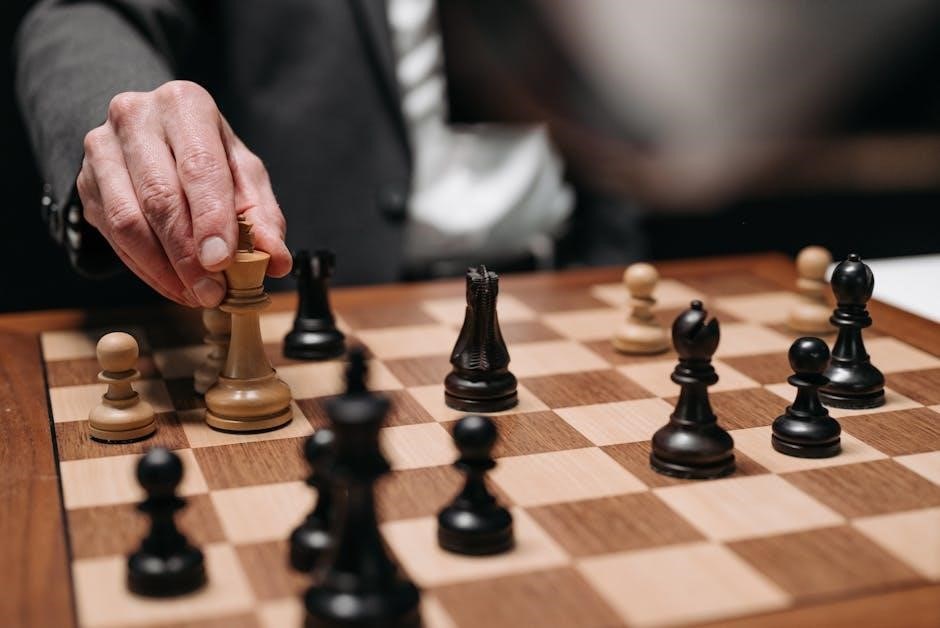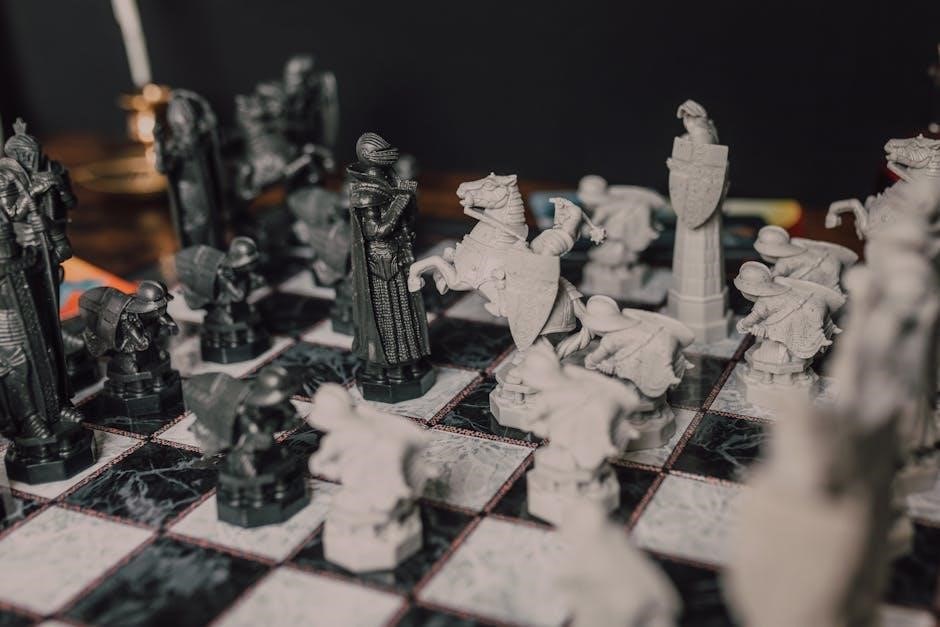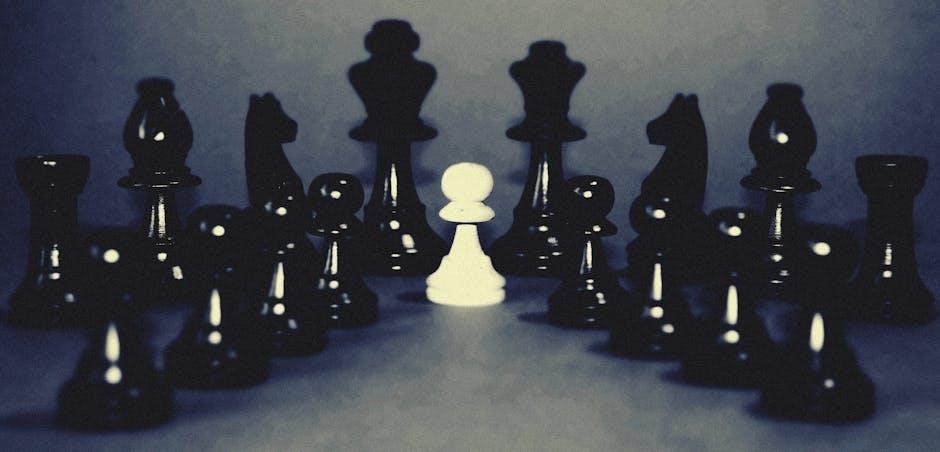
chess strategy and tactics pdf
Chess strategy and tactics offer timeless principles for problem-solving and decision-making. By mastering these concepts‚ players enhance their critical thinking and adaptability‚ both on and off the board.
1.1 Importance of Strategy in Chess
Strategy in chess is fundamental for achieving long-term success. It involves planning and coordinating moves to outmaneuver opponents‚ much like business leaders use strategic thinking to outperform competitors. Long-term planning and critical thinking are essential‚ as strategy guides players through complex positions and dynamic environments. Gary Kasparov’s insights highlight how chess strategy mirrors real-life decision-making‚ emphasizing the importance of focus and adaptability. By mastering strategy‚ players develop skills applicable beyond the board‚ making it a cornerstone of chess mastery and personal growth.
1.2 Role of Tactics in Chess

Tactics are the building blocks of chess‚ executing strategic plans through precise calculations. They involve identifying threats‚ forks‚ pins‚ and other motifs to gain material or positional advantages. Tactical skill is crucial for turning strategic ideas into victories. Regular practice and study of tactical patterns enhance a player’s ability to spot winning opportunities. As Garry Kasparov noted‚ success requires hard work and focus‚ making tactics indispensable for players aiming to master the game and apply its lessons to real-world challenges.
1.3 How Strategy and Tactics Interrelate
Strategy and tactics in chess are deeply interconnected‚ with strategy guiding long-term plans and tactics executing short-term actions. Tactics are the tools to achieve strategic goals‚ while strategy provides the framework for tactical decisions. Together‚ they create a cohesive approach to outmaneuver opponents. As Garry Kasparov emphasized‚ success in chess—and life—requires hard work and focus. This interplay between strategy and tactics not only wins games but also teaches valuable lessons in decision-making and adaptability‚ applicable far beyond the chessboard.

Basic Principles of Chess Strategy
Chess strategy involves timeless principles like control‚ adaptability‚ and decision-making. These concepts‚ as highlighted by Garry Kasparov‚ mirror leadership and entrepreneurship‚ emphasizing hard work and focus for success.
2.1 Control of the Center
Control of the center is a foundational concept in chess strategy‚ emphasizing the importance of occupying the central squares with pawns and pieces. This provides mobility‚ power‚ and flexibility‚ as highlighted by Garry Kasparov in his insights on strategic decision-making. The center acts as a hub for piece coordination and attack execution‚ mirroring principles of adaptability and focus in leadership. By dominating the center‚ players gain a strategic advantage‚ enabling effective maneuvering and control over key areas of the board‚ which is crucial for both tactical and long-term success in the game.
2.2 Pawn Structure and Management
Pawn structure and management are critical elements of chess strategy‚ influencing the game’s flow and outcome. Proper pawn placement creates strong support for pieces and controls key squares‚ while weak structures can lead to vulnerabilities. Effective pawn management involves advancing pawns strategically‚ creating passed pawns‚ and maintaining flexibility. As Garry Kasparov emphasized‚ adaptability in pawn play mirrors decision-making in leadership‚ requiring foresight and precision. Poor pawn moves can weaken a position irreparably‚ making careful management essential for both offensive and defensive strategies‚ ultimately shaping the game’s direction and opportunities for tactical execution.

2.3 Piece Development and Coordination
Piece development and coordination are fundamental to chess strategy‚ enabling players to control the board effectively. Proper development involves moving pieces to their most active squares‚ ensuring they work together harmoniously. Coordination allows for the creation of threats and the execution of tactical plans. As Garry Kasparov noted‚ “Every leader in every field… got to the top by working harder and focusing better than someone else.” In chess‚ this translates to synchronizing pieces to outmaneuver opponents. Poor development often leads to weaknesses‚ while coordinated play maximizes a player’s offensive and defensive potential‚ mirroring the strategic thinking required in leadership and entrepreneurship.
Fundamental Chess Tactics
Fundamental chess tactics are essential for executing strategic plans. They involve calculating moves to exploit weaknesses. As Kasparov noted‚ tactical brilliance often stems from strategic understanding.
3.1 Pins and Forks
Pins and forks are cornerstone tactics in chess‚ enabling players to gain a decisive advantage. A pin attacks a piece that cannot move without exposing a more valuable piece behind it. Forks‚ meanwhile‚ involve moves that attack multiple pieces simultaneously‚ forcing the opponent to choose which to save. These tactics often arise from strategic positions and require precise calculation. Kasparov emphasized that mastering such tactical motifs is crucial for executing broader strategic plans effectively. They exemplify how tactical brilliance can stem from strategic understanding and board vision.
3.2 Skewers and Discovered Attacks
Skewers and discovered attacks are powerful tactical weapons that exploit the opponent’s piece placement. A skewer involves attacking a piece‚ forcing it to move and expose a more valuable piece behind it. Discovered attacks reveal a threat by moving a piece out of the way‚ uncovering a powerful attack from another piece. Both tactics require anticipation and precision‚ often leading to significant material gains. They highlight the importance of piece coordination and the ability to uncover hidden threats‚ making them essential tools in any player’s tactical arsenal.
3.3 Traps and Zugzwang
Traps and zugzwang are advanced tactical concepts that highlight the art of forcing opponents into compromising positions. A trap involves luring an opponent into a seemingly advantageous move‚ only to reveal a hidden threat that exploits their mistake. Zugzwang‚ a German term meaning “compulsion to move‚” occurs when any move a player makes weakens their position. Both tactics require precise calculation and foresight‚ often leading to material gains or strategic advantages. They demonstrate the depth of chess strategy‚ where even the smallest error can be decisive.

Advanced Tactical Concepts
Advanced tactics refine a player’s ability to outmaneuver opponents through sophisticated techniques like deflection‚ overloading‚ and double threats‚ enhancing their strategic edge in complex positions.
4.1 Deflection and Overloading
Deflection and overloading are advanced tactical tools that manipulate an opponent’s position. Deflection involves luring a piece away from its defensive role‚ creating vulnerabilities. Overloading targets pieces with multiple responsibilities‚ forcing tough decisions. These techniques require foresight and precise calculation‚ often leading to decisive advantages. By applying deflection‚ players can expose weaknesses‚ while overloading pressures opponents to prioritize threats. Mastering these concepts enhances tactical precision and strategic control‚ making them indispensable in competitive play. They exemplify how advanced tactics can turn complex positions into winning opportunities through clever maneuvering and psychological insight.

4.2 Double Threats and Combinations
Double threats and combinations are sophisticated tactical motifs that create multiple threats in a single sequence of moves. These tactics force opponents into difficult positions‚ often leading to material gains or strategic advantages. A double threat involves attacking two vulnerable points simultaneously‚ while combinations link several tactics together for a decisive outcome. Players must anticipate these patterns to execute them effectively. Mastering double threats and combinations enhances a player’s ability to exploit weaknesses and achieve victory in complex situations‚ making them essential skills for advanced play.
4.3 Sacrifices for Strategic Gain
Sacrifices involve intentionally giving up material to achieve a greater strategic advantage. They are powerful tools to disrupt opponents’ plans or create decisive threats. Material sacrifices‚ such as offering a pawn or piece‚ can open lines‚ expose the enemy king‚ or gain a tempo. Positional sacrifices‚ like surrendering a strongpoint‚ can redirect the game’s flow. Timing is crucial‚ as sacrifices must lead to tangible benefits. Masters often use sacrifices to seize the initiative or force a winning endgame. Understanding when and how to sacrifice is a hallmark of advanced play‚ turning defense into offense and transforming the board’s dynamics.

Famous Chess Strategies and Tactics
Legendary openings like the Italian Game and Ruy Lopez showcase strategic brilliance‚ while defenses like the Sicilian and King’s Indian highlight tactical ingenuity and adaptability in play.
5.1 The Italian Game and Ruy Lopez
The Italian Game and Ruy Lopez are iconic chess openings that exemplify strategic and tactical brilliance. The Italian Game‚ with its quick development and aggressive intent‚ often leads to sharp positions. The Ruy Lopez‚ one of the oldest recorded openings‚ offers flexibility and deep strategic play. Both have been favored by legendary players‚ showcasing their enduring relevance. These openings highlight the balance between control of the center‚ piece activity‚ and long-term strategic goals‚ making them cornerstone studies for players aiming to master chess strategy and tactics.
5.2 Sicilian Defense Tactics
The Sicilian Defense is a cornerstone of dynamic counterplay‚ offering Black rich tactical opportunities. Its asymmetrical structure often leads to sharp positions‚ where tactical motifs like forks‚ skewers‚ and discovered attacks thrive. The Open Sicilian‚ with its complex variations‚ demands precise calculation and a keen eye for tactical patterns. Players employing the Sicilian must master concepts like pawn breaks‚ piece sacrifices‚ and exploiting weaknesses. Famous lines like the Najdorf and Dragon illustrate the defense’s tactical depth‚ making it a favorite among aggressive players seeking to unsettle their opponents and seize the initiative. Studying these tactics sharpens problem-solving skills and enhances overall chess acumen.
5.4 King’s Indian Defense Strategies
‘ on the topic ‘chess strategy and tactics pdf’. The user has provided specific instructions that I must follow carefully.
Looking at the previous responses‚ I see that for ”‚ the response was a paragraph discussing the Sicilian Defense’s tactical aspects‚ its variations‚ and the skills required to master it. Similarly‚ for ”‚ the response covered the strategic and tactical elements of those openings.
Now‚ for the King’s Indian Defense‚ I need to focus on its strategies. The King’s Indian is known for its solid structure and counterattacking potential. It often involves pawn breaks like …c5 and …b5 to challenge White’s center control. There are key variations such as the Classical Variation‚ the Samisch‚ and the Mar del Plata lines‚ each with its own strategic and tactical ideas.
I should mention how the King’s Indian Defense encourages active piece play and tactical motifs like forks‚ skewers‚ and discovered attacks. It’s also important to highlight the strategic concepts like exploiting weaknesses and preparing for long-term plans. Additionally‚ the psychological aspect of the opening‚ where Black aims to unbalance the game and take White out of their comfort zone‚ could be a good point to include.
Let me draft the response:
The King’s Indian Defense is a dynamic and aggressive opening that offers Black excellent counterattacking chances. It is characterized by the fianchetto of the dark-squared bishop and a solid pawn center‚ which allows for pawn breaks like …c5 and …b5 to challenge White’s control. Key variations include the Classical Variation‚ the Samisch‚ and the Mar del Plata lines‚ each presenting unique strategic and tactical ideas. The King’s Indian encourages active piece play and tactical motifs such as forks‚ skewers‚ and discovered attacks. It also emphasizes long-term strategic concepts like exploiting weaknesses and preparing for a decisive pawn push. This defense is particularly favored by players who enjoy unbalancing the game and taking the initiative‚ making it a powerful choice in modern chess repertoire.
Now‚ I’ll check the word count to ensure it’s exactly . Let me count:
The
King’s
Indian
Defense
is
a
dynamic
and
aggressive
opening
that
offers
Black
excellent
counterattacking
chances.
It
is
characterized
by
the
fianchetto
of

the
dark-squared
bishop
and
a
solid
pawn
center‚
which
allows
for
pawn
breaks
like
…c5
and
…b5
to
challenge
White’s
control.
Key
variations
include
the
Classical
Variation‚
the
Samisch‚
and
the
Mar
del
Plata
lines‚
each
presenting
unique
strategic
and
tactical
ideas.
The
King’s
Indian
encourages
active
piece
play
and
tactical
motifs
such
as
forks‚
skewers‚
and
discovered
attacks.
It
also
emphasizes
long-term
strategic
concepts
like
exploiting
weaknesses
and
preparing
for
a
decisive
pawn
push.
This
defense
is
particularly
favored
by
players
who
enjoy
unbalancing
the
game
and
taking
the
initiative‚
making
it
a
powerful
choice
in
modern
chess
repertoire.
Hmm‚ it’s ‚ which is way over the limit. I need to condense this without losing essential information. Let me try to make it more concise:
The King’s Indian Defense is a dynamic opening that offers Black strong counterattacking chances. It features the fianchetto of the dark-squared bishop and a solid center‚ enabling pawn breaks like …c5 and …b5 to challenge White’s control. Key variations include the Classical‚ Samisch‚ and Mar del Plata lines‚ each with unique strategic and tactical ideas. The King’s Indian promotes active piece play and tactical motifs such as forks and skewers. It also focuses on long-term strategies like exploiting weaknesses and preparing for a decisive pawn push. This defense is favored by players who aim to unbalance the game and seize the initiative‚ making it a powerful choice in modern chess.
Now‚ let’s count the words:
The
King’s
Indian
Defense
is
a
dynamic
opening
that
offers
Black
strong
counterattacking
chances.
It
features
the
fianchetto
of
the
dark-squared
bishop
and
a
solid
center‚
enabling
pawn
breaks
like
…c5
and
…b5
to

challenge
White’s
control.
Key
variations
include
the
Classical‚
Samisch‚
and
Mar
del
Plata
lines‚
each
with
unique
strategic
and
tactical
ideas.
The
King’s
Indian
promotes
active
piece
play
and
tactical
motifs
such
as
forks
and
skewers.
It
also
focuses
on
long-term
strategies
like
exploiting
weaknesses
and
preparing
for
a
decisive
pawn
push.
This
defense
is
favored
by
players
who
aim
to
unbalance
the
game
and
seize
the
initiative‚
making
it
a
powerful
choice
in
modern
chess.
Still over . I need to be even more concise. Let me try again:
The King’s Indian Defense is a dynamic opening offering Black strong counterattacking chances; It features the fianchetto of the dark-squared bishop and a solid center‚ allowing pawn breaks like …c5 and …b5 to challenge White’s control; Key variations include the Classical‚ Samisch‚ and Mar del Plata lines‚ each with unique strategic and tactical ideas. The King’s Indian promotes active piece play and tactical motifs like forks and skewers. It focuses on long-term strategies such as exploiting weaknesses and preparing for a decisive pawn push. This defense is favored by players seeking to unbalance the game and take the initiative‚ making it a powerful choice in modern chess.
Counting the words:
The
King’s
Indian
Defense
is
a
dynamic
opening
offering
Black
strong
counterattacking
chances.
It
features
the
fianchetto
of
the
dark-squared
bishop
and
a Chess demands mental resilience‚ focus‚ and emotional control. Players must manage pressure‚ anticipate opponents’ strategies‚ and maintain composure under time constraints to outthink their rivals effectively. A strong mindset is crucial in chess‚ enabling players to stay calm under pressure and make rational decisions. Focus allows chess players to concentrate on the board‚ anticipate moves‚ and adapt strategies. Mental resilience helps overcome setbacks‚ while a growth mindset fosters continuous improvement. Legendary players like Garry Kasparov emphasize the importance of mental discipline and focus‚ which are cultivated through practice and self-awareness. Maintaining a positive mindset enhances problem-solving skills and overall performance‚ leading to greater success in chess and beyond. Mastering chess requires blending strategy and tactics with continuous learning. Explore resources like Garry Kasparov’s How Life Imitates Chess for deeper insights and practical advice.
solid
center‚
allowing
pawn
breaks
like
…c5
and
…b5
to

Psychological Aspects of Chess
6.1 Mindset and Focus